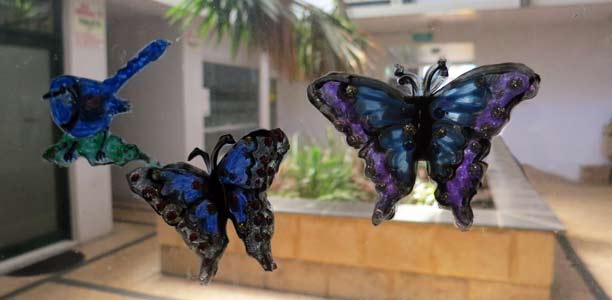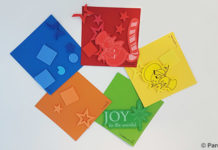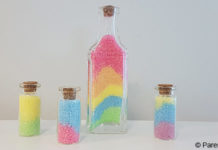Age
2 years and over
Duration of activity
This activity can last about 30 minutes, depending on how much of the activity your child does on their own (age-dependent).
Materials/equipment
- Transparent plastic sheets (the type sold by the metre as disposable tablecloths at haberdashery stores like Spotlight)
- A permanent marker
- Scissors
- Paint
Cost
Plastic sheets cost about $5 per metre- a metre is more than enough to make several window decorations. If you do not already have paints, a permanent marker and scissors, they’re a great investment for your child’s craft box and you can buy them cheaply from a stationary shop or $2 shop.
Preparation
- Buy the plastic sheets from a haberdashery store.
- Prepare an area where your child can do the painting and clothes that they can paint in.
What to do
- You can make full window murals or little designs.
- For a full window mural, take a sheet of plastic which is large enough to fit in the window you want to decorate. For a little stained glass window, cut a square/rectangle of plastic to the rough size their design will be.
- Draw the outline of a picture your child would like to paint and hang in a window. Older children will be able to draw or trace the outline themselves. For younger children you will need to draw the outline for them. You can use any picture, for example your child’s favourite character or just about anything else your child likes, just as long as the outline is big enough for your child to paint inside of.
- Give your child the plastic and ask them to take it to the painting area to paint it. Your child should then paint the picture.
- Leave the painting lying flat to dry.
- When it is dry, if you are using a small design cut around the figure or picture. (If you are doing a full window mural no cutting will be necessary).
- Place it in the window- it will stick there on its own.
Extension activities
- You could also give your child plastic sheets to paint their own pictures on (without tracing the outline). This is a fun way for kids to get creative and express their emotions through art.
Tips
- Making window decorations is a great activity for special occasions like Christmas, Chinese New Year, birthdays, NAIDOC (National Aborigines and Islanders Day Observance Committee) week, Eid, Passover or any other special day your family celebrates.
- If you can’t draw to save your life, don’t despair- transparent plastic is perfect for tracing. You could trace the outline of a picture in their favourite book or find a picture online and print it out for tracing. Just place the picture underneath the plastic and copy the outline.
- Display the window decorations in windows that are at your child’s eye level so they can see them easily.
Educational outcomes
Creativity
Art and craft projects are a great opportunity for your child to explore their creativity. For example when painting your child has an opportunity to express their creativity by choosing the colours they want to paint in (when they are young) or experimenting with different patterns or brush strokes (as they grow older). Giving them the materials and time they need to explore their creativity is an important part of helping them develop their creative abilities.
Fine motor skills
Painting and drawing are fun ways to help children develop control of the fine muscles in their fingers. As they hold the paint brush they will be training their fingers to make fine movements that they will use throughout their lives to do things like write, turn the pages of books and pick up small objects. Toddlers will start by clutching the paintbrush in their fist. By 3-5 years of age a child should be gripping it properly between their thumb and forefinger (although they’ll probably still be moving their whole arm to move the paintbrush. By 6-8 years your child should be able to paint by moving their fingers, rather than their whole arm. They may also be able to cut neatly around the picture by this age.
Communication and language skills
As you and your child do this kids craft activity, the conversation you have with them will help them develop their language skills and their understanding of communications. For example they will learn new words when they hear you using them and have a chance to practice using the new words themselves. They will develop a better understanding of the conventions of conversations, things like taking turns and replying when someone them asks a question. Be conscious of speaking clearly and using language that’s appropriate for your child’s age (e.g. for a young child use simple sentences that they can understand).
Window decorations will also communicate messages to neighbours and passers-by, for example that your family is celebrating a particular event (e.g. a tree or a star is a symbol that represents Christmas), or that your child likes a particular character (so much that they wanted to hang it in their window). Discussing this can help your child understand the non-verbal ways in which we communicate and the different meanings symbols have.
Social and emotional development
A window painting is an object your child can take great pride in. Kids love praise and attention from parents. But don’t praise your child if a compliment is not deserved, for example if they did not challenge themselves. When they’ve worked hard and deserve praise, be specific about your compliments. Rather than telling your child that they’ve done a ‘great job’, choose a specific part of their work to compliment and make sure you mention the skills they’ve applied to accomplish the task. For example say, ‘your painting is very neat, you’re getting very good at using the paintbrush,’ or, ‘you’ve finished painting the whole picture- I can see you concentrated very hard.’ If you have a 3-5 year old, they’re at the age where they like to boast about their achievements, so you might just hear them proudly telling their friends about their wonderful window decoration.
Making window decorations for special occasions is also a great way to teach your child about their social world and the different people they share it with. For example, making decorations for NAIDOC week provides an opportunity to discuss Indigenous Australian culture with your child and making decorations for holidays celebrated by people of different religions can increase their awareness of religious diversity. Learning about the similarities and differences amongst people is an important part of social development in early childhood.
References
- Early Childhood Development Alignment Program. Milestones of child development- A guide to young children’s learning and development from birth to kindergarten. 2009. (cited 8 December 2013). Available from: (URL Link)
- Queensland Health. Child Development milestones 6-8 years. 2006 (modified 2013). (cited 8 December 2013). Available from: (URL Link)
- Australian Government Department of Education, Employment and Workplace Relations. Development Milestones and the Early Years Learning Framework and the National Quality Standards. 2012 (cited 8 December 2013). Available from: (URL Link)
- Siegle D. Compliment Students on the Skills they Develop. 2000. (cited 10 December 2013). Available from: (URL Link)



 (4 votes, average: 4.00 out of 5)
(4 votes, average: 4.00 out of 5) 






